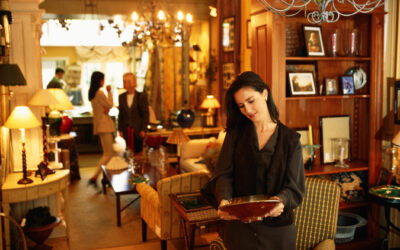It’s a $42,000 mistake that happened recently at an art exhibit in Miami. The most famous balloon dog sculpture in the U.S. was accidentally knocked over by an attendee — and it shattered into pieces. Wait a minute..? Why didn’t they place that sculpture under protective glass or something? Good point! But the bigger question is, “Who’s going to pay for it?”
It’s hard to account for every possible scenario ahead of time (like in this case), and this is where the need for fine collectibles insurance comes in.
Fine collectibles, especially the antique kind, come in all sorts of shapes, sizes, and values. Your client may have a collection of fine art paintings, a stamp collection from the 1800s, a collection of rare figurines, or even a 98-piece set of 19th century porcelain dessert plates once used by Queen Elizabeth II. If anything happens to these collections, the sentimental value will be lost — but the monetary value does not have to be.
Does your client have the right insurance for situations like a broken balloon dog sculpture? Read on to find out how you can insure their treasured antiques and fine collectibles.
Determine the Value of the Collectibles
Sure, there’s a subjective value to any given collection — certain memories and sentiments are attached to them. In that way, a collection can be priceless. But, at the same time, it’s important to know the monetary value too. This way, a client can be fairly compensated if an accident happens.
It can be a cumbersome task to figure out the price of each individual fine art piece or antique item – especially if there are hundreds of them in a collection. That’s why it’s so important for collectors to document each item as the collection grows. Printed or digital records such as transaction receipts, certificates of authenticity, and letters of provenance help to establish the collectible value of an item. These records are extremely helpful in the event that your client needs to file an insurance claim for loss or damage. But what you paid for that album of rare stamps 20 years ago might not reflect its value today. For that, you need an appraisal.
Hire an Appraiser For Fine Art and Antique Collectibles
The current value of fine art collections and collections of other items may change over time. Documents and receipts help to establish only part of an item’s value. For a more complete assessment, it may be helpful to hire a professional appraiser. This way, your client won’t be making a blind guess that could be way off the mark in terms of the appreciated value of individual items or collections. There are three main organizations that provide professional certification in appraisal:
- The American Society of Appraisers (www.appraisers.org)
- The Appraisers Association of America (https://www.appraisersassociation.org/)
- The International Society of Appraisers (https://www.isa-appraisers.org/)
With an appraisal in hand, you and your client will be prepared when it comes to purchasing fine collectibles insurance or filing an insurance claim.
Understand the Possible Gaps in Insurance Coverage for Fine Arts Collectibles
There’s a common misconception that homeowners insurance and renters insurance provide sufficient coverage for fine arts collectibles. However, these types of policies typically provide only limited coverage for collectibles and items expected to appreciate in value.
There are many ways that fine arts and antique collectibles can become damaged. For example, a collection can be damaged by water, humidity, smoke, or fire. Let’s not forget about theft or even loss in transit. If your client’s collections are covered only by homeowners or renters insurance, it is critical that you review the available coverage with them. In many cases, it will not be adequate in terms of limits or property valuation. For protecting fine arts and antique collectibles, obtaining specialty insurance will often be the preferred route.
In addition, it’s important for brokers and collectors to consider the importance of properly caring for, storing, and displaying items as part of the overall conversation about insuring fine arts collectibles. For example, here are 10 expert tips for protecting fine art pieces.
- Limit or avoid direct sunlight
- Select appropriate framing materials (acrylic or glass)
- Keep frames clean
- Dust paintings and never use cleaning solutions or solvents
- Monitor humidity
- Avoid touching pieces with bare hands
- Store art flat – not rolled in a tube
- Separate each piece of stored art with a non-acidic buffer
- Store art in a cool, dark environment
- Invest in specialized storage boxes or containers
If you have a client who is an all-star collector, contacting a specialty coverage provider is the first step in making sure you cover and protect the full value of their collection, leaving no room for gaps. MiniCo’s Fine Art and Collectibles Insurance program covers hundreds of types of collections, from fine art and antiques to sports memorabilia and more. Connect with an underwriter to learn more about insuring fine art collectibles or get a fast quote through our online portal.




